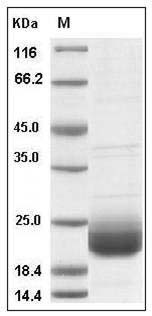-
Product Name
Human LAIR2 (CD306) recombinant protein
- Documents
-
Description
Leukocyte-associated immunoglobulin-like receptor 2 ( LAIR2 ), also known as CD306, is a 131 amino acid protein containing one lg-like C2-type domain. It is expressed as a soluble receptor exhibiting high affinity for various collagen molecules to which it binds in a hydroxyproline-dependent manner. LAIR2 is a member of the immunoglobulin superfamily and was identified by its similarity to LAIR1, an inhibitory receptor present on mononuclear leukocytes. LAIR2 is thought to be secreted and may help modulate mucosal tolerance. As a natural competitor for LAIR1, soluble LAIR2 prevents binding of human LAIR1 to collagens and LAIR1 cross-linking, thereby regulating its inhibitory potential. Accordingly, LAIR2 is suggested to perform an immunoregulatory function.
-
Protein name
Leukocyte-associated immunoglobulin-like receptor 2
-
Protein short names
MGC71634; LAIR2; CD306; XXBAC-BCX535A19.6
-
Uniprot ID
Q6ISS4
-
Gene Name
LAIR2; CD306
-
Source/Expression Host
Human Cells
-
Expression Plasmid/cDNA
A DNA sequence encoding the human LAIR2 (NP_002279.2) (Met 1-Pro 152) was expressed and purified.
-
Protein Species
Human
-
Molecular weight
The secreted recombinant human LAIR2 comprises 131 amino acids with a predicted molecular mass of 14.1 kDa. As a result of glycosylation, the apparent molecular mass of rh LAIR2 is approximately 22 kDa in SDS-PAGE under reducing conditions.
-
Purity
> 93 % as determined by SDS-PAGE
-
Activity
Measured by the ability of the immobilized protein to support the adhesion of HT-29 human colon adenocarcinoma cells. When 5 x 10E4 cells/well are added to recombiannt human LAIR2 coated plates (50 μg/ml with 100 μl/well), >30% will adhere after 30 minutes at 37℃. Optimal concentration depends on cell type as well as the application or research objectives.
-
Validations

Human LAIR2 / CD306 Protein SDS-PAGE
Related Products / Services
Please note: All products are "FOR RESEARCH USE ONLY AND ARE NOT INTENDED FOR DIAGNOSTIC OR THERAPEUTIC USE"
